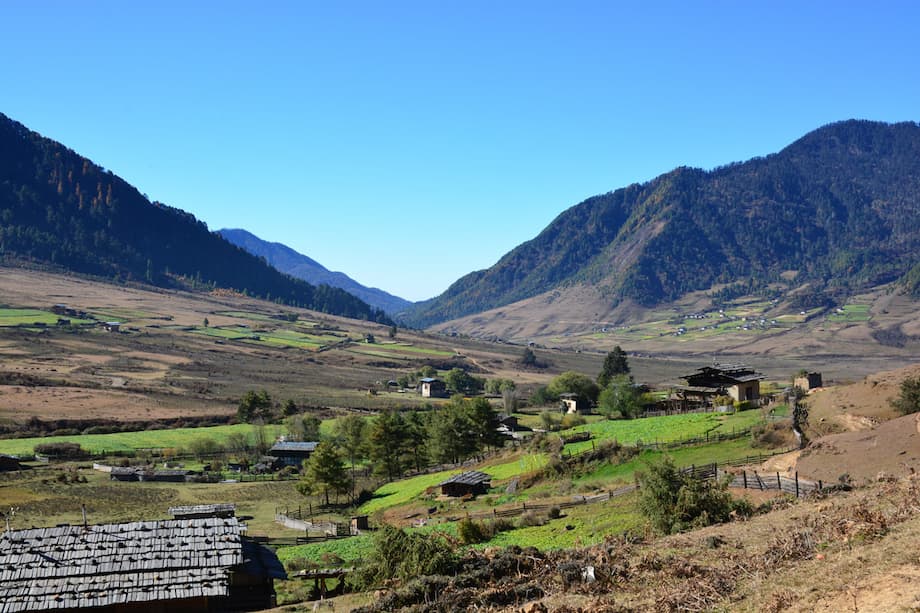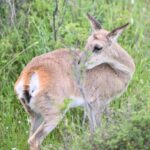A tradition under strain in a Himalayan valley
Phobjikha in Wangdue Phodrang once sustained thousands of sheep that supplied wool, manure, and a steady rhythm of work for families who spun and wove their own winter clothing. Today the valley counts roughly 351 sheep across two chiwogs. The drop is stark, and it points to a way of life at risk of disappearing as households move toward higher earning crops, young people leave for towns, predators strike more often, and pasture access tightens.
- A tradition under strain in a Himalayan valley
- How did a thriving flock shrink so quickly?
- What makes Jakar sheep unique
- Economics that push farmers toward potatoes
- Predators, feral dogs, and shrinking pasture
- Traditions fading on summer pastures
- What has been tried so far
- Paths that could keep flocks on the landscape
- Why this matters beyond one valley
- The Bottom Line
Recent data shows the slide is continuing. According to the Integrated Agriculture and Livestock Census of Bhutan 2025, Phobjikha recorded 351 local sheep, including 96 males and 255 females, with two recorded deaths and 0.20 metric tonnes of wool produced. In 2023, the valley had 426 sheep, with 46 deaths and 0.49 metric tonnes of wool. In 2022, the figure was sharply higher at 770 sheep and 3.57 metric tonnes of wool. The fall in both flock size and wool output captures a hard reality facing older herders who remain on the land.
Bhutan recognizes four types of native sheep, Jakar, Sipsu, Sarpang, and Sakten. Jakar sheep, believed to be associated with Phobjikha and found in central districts like Bumthang and Trongsa, are now vulnerable. As more families exit herding, the risk grows that a distinct local breed and the knowledge surrounding it will shrink to a remnant. Local reporting has tracked the same trend, with detailed accounts of farmers turning to potatoes and younger residents leaving for city jobs Kuensel.
How did a thriving flock shrink so quickly?
Phobjikha once had more than 2,000 sheep in 2013, according to the gewog’s livestock extension agent. The sustained decline since then has multiple causes. Herding is time consuming and physically demanding. Flocks need close supervision for grazing, protection from predators, and seasonal movements to pasture. Those tasks are difficult when most remaining herders are elderly and household labor is scarce. The pull of steady cash income from potatoes makes the choice clearer for many families. The result is a gradual exit from sheep, even among people who value the tradition.
Migration adds pressure. Younger villagers often head to urban centers for schooling and work, leaving a small number of older residents to manage animals. With fewer hands available, families reduce herd size or sell entire flocks. At the same time, pasture access is a long running constraint. Local leaders describe the lack of tsamdro, or pastureland, as a core barrier. When grazing areas are far from homes or rules are unclear, daily herding becomes harder and costly.
The pattern is not limited to one valley. Bhutan’s sheep population has been falling for years, with the national broadcaster reporting a steady annual decline and severe losses to wildlife in some villages Bhutan Broadcasting Service. Even with a national total near 10,000 sheep as of late 2023, numbers are concentrated in a few districts. Samtse alone accounted for more than half the national flock in 2024, with more than 5,000 sheep. Many other places now keep only small herds.
What makes Jakar sheep unique
Jakar sheep are part of Bhutan’s livestock heritage, adapted to central highland environments and valued for wool used in blankets, clothing, and local textiles. Farmers once relied on that wool to spin yarn at home. These animals fit the climate and the agricultural cycle, and they connect to customs around seasonal grazing and offerings to local deities. Their decline matters for livelihoods and for the country’s animal genetic diversity.
A native breed with cultural weight
Genetic studies and local records highlight distinct categories of Bhutanese sheep, including Jakar in central Bhutan. A government supported program in Phobjikha encouraged owners to keep Jakar sheep by offering breeding rams, veterinary care, simple wool processing tools, and training. That effort aimed to keep herds on the landscape while improving the quality and market value of wool. Similar reviews of farm animal genetic resources stress that conserving native breeds requires action in communities and support across agencies, because local livestock often fall in number when smallholders shift to faster paying activities.
Despite that intent, on the ground conditions make continuity difficult. Where households see limited returns, they sell animals or retire from herding. In Phobjikha, local leaders say even the cooperative formed to support sheep, the Samdrup Phuentshog Lug Detshen, and the equipment provided under a partnership with the National Biodiversity Centre, did not change farmer choices. The Jakar sheep’s future in the valley now hinges on whether a small number of committed households can keep going or whether a new model emerges that makes rearing more practical.
Economics that push farmers toward potatoes
The most common reason farmers give for exiting sheep is simple math. Wool pays too little for the labor it demands. Farmers report a price of roughly Nu 450 to Nu 500 for a kilogram of wool. Shearing, sorting, washing, spinning, and weaving take time. Constant herding and night pens add more work. Losses to dogs and wild animals can wipe out months of care in a single night. When incomes are uncertain, people choose potatoes and other crops with clearer prices and buyers.
Potatoes in Phobjikha have a long run of reliable sales. The crop fits local soils and climate, and market access has improved with better roads. Buyers often come directly to the valley during harvest, cash payment is quick, and labor can be hired for short periods. Wool, by contrast, requires months of care before a sale and often needs processing to reach better prices. The shift is understandable for families who need stable income each season.
There is room to increase the value of wool with new products. The National Sheep Farm in Bumthang has trained farmers to make felted items and expand beyond traditional cloths like yathra and Bumthang mathra. If skills and buyers grow, these crafts could raise earnings per kilogram of wool. That said, it takes coordination, design support, and steady supply to turn scattered flocks into a dependable cottage industry.
Predators, feral dogs, and shrinking pasture
Predation is a daily threat for herders in Phobjikha and other districts. Feral dogs attack frequently. Bears and other wildlife take animals, especially when flocks graze far from villages. In Chumey, Bumthang, villagers told the national broadcaster they lost sheep every day and in some cases entire pens in one night. Those losses hit morale and finances. Families cannot afford to raise animals for months only to see them taken before shearing or sale.
Pasture constraints add to the challenge. Tsamdro access has long shaped where and how herders move flocks. When grazing is scarce, far, or contested, daily herding becomes risky and tiring. In the past, Phobjikha families drove their sheep to summer grazing grounds in the Black Mountains, relying on yak herders to watch them. That practice has nearly faded as many yak herders sold their animals and movement patterns changed. With both pasture and caretakers fewer in number, the old circuits are harder to sustain.
Predator proof pens, effective dogs that guard livestock, and coordinated stray dog management have helped in other pastoral regions. Each step requires local buy in and resources. When villages are aging and labor is short, even commonsense measures can be hard to organize without outside support or incentives.
Traditions fading on summer pastures
Many elders remember when most households kept large flocks, sometimes 200 sheep each. Wool was turned into blankets and clothing that kept families warm in long winters. Seasonal routines brought communities together during shearing and weaving. Those habits tied closely to the landscape and to the cultural life of the valley, which is also known for black necked cranes that winter in its wetlands.
Now only a few households in some chiwogs still keep sheep. Local leaders say most sheep are sold out of the valley, often to Bumthang. The custom of sending flocks to the Black Mountains for summer grazing, under the care of yak herders, is almost gone. Even weaving of woolen clothes has slowed to a trickle as people can buy ready made garments from markets connected by better roads. One tradition that endures in a few homes is the offering of a male sheep to a local deity, a practice believed to support household health and harmony. That link to belief remains, even as daily herding has grown harder.
Where are the sheep going?
Some villagers say they sell breeding animals to buyers from central districts where herding networks remain stronger. With more than half of Bhutan’s sheep now in a single district, Samtse, there is a sense that herds are consolidating where pasture and markets still fit. For Phobjikha, the concern is that the remaining flock, currently around 351 sheep, could dwindle to zero if no fresh households take up the work.
What has been tried so far
Phobjikha leaders, herders, and national agencies have attempted to keep sheep viable. A local cooperative, Samdrup Phuentshog Lug Detshen, was formed with support from the National Biodiversity Centre. Equipment such as a wool shredding machine was distributed to farmers. The aim was to ease processing and spark community momentum. The initiative did not gain enough traction to reverse the decline, in part because labor and predator issues remained unchanged and prices for wool stayed low.
At national level, the center in Bumthang supplies animals and training to interested farmers. Training covers shearing, basic health care, and new product lines like wet and dry felting to turn wool into higher value goods. Officials have pointed to the need for more diverse products beyond traditional cloths and for market development that can absorb small but steady volumes. Reviews of farm animal genetic resources in Bhutan underline the need for conservation of native breeds through a mix of on farm support and strategic programs. Those reviews also point out that without demand and income, even well designed breeding plans struggle to succeed.
Paths that could keep flocks on the landscape
Examples from pastoral regions elsewhere suggest a set of practical steps that can reduce losses and improve returns. Predator proof night pens built of sturdy mesh, lights, and raised platforms lower losses. Livestock guardian dogs, properly trained and managed, can deter feral dogs and wildlife. Community herders hired to rotate among flocks can ease the burden on elderly residents. A small cooperative to pool wool, standardize quality, and sell to buyers can lift prices above what single families manage.
On the demand side, branding Jakar wool as a native, highland fiber can help. Designers and craft groups can co create products that match buyer tastes while keeping traditional motifs. Training in felting and simple weaving can expand the product range, which may include clothing, bags, toys, and home goods. Partnering with hotels and tour providers in crane season could create a market for locally made items, with sales that support conservation of both sheep and the valley’s cultural landscape.
Policy measures also matter. Clear pasture access, seasonal agreements with caretakers in high ground, and support for mobile shearing or veterinary services can reduce the day to day cost of herding. Modest grants for predator proof infrastructure and guardian dogs can prevent losses that often push families out of livestock. Compensation for verified predation losses, used in some countries, can steady household budgets. None of these steps is a single fix. Together they can change the balance for families deciding whether to keep sheep.
Why this matters beyond one valley
Phobjikha’s flocks are part of Bhutan’s wider story of indigenous livestock. National reviews describe declines across several species, including yak, buffalo, equine, pig, sheep, and goat. Preserving animal genetic resources helps maintain traits like hardiness, disease resistance, and adaptation to local climates. It also carries cultural value, since herding practices and crafts link strongly to place and identity.
Losing Jakar sheep in Phobjikha would narrow Bhutan’s livestock diversity and reduce the skills tied to wool. Rural livelihoods would also be affected. Sheep manure contributes to soils. Livestock distribute risk when crops fail. Crafts offer seasonal income for women and elders. When flocks vanish, that mix of benefits shrinks, and communities lean more heavily on a single crop. Keeping some sheep on the land, even at small scale, supports a more balanced rural economy.
The Bottom Line
- Phobjikha’s sheep have fallen to about 351 animals across two chiwogs, down from more than 2,000 in 2013.
- Official data shows the valley’s flock dropped from 770 in 2022 to 426 in 2023 and 351 in 2025, with wool output also down.
- Families cite better potato income, labor shortages, and constant predator threats as main reasons for leaving herding.
- Jakar sheep, a native breed tied to central Bhutan, face higher risk as herds shrink in their traditional strongholds.
- Predation by feral dogs and wildlife, and limited pasture access, make daily herding difficult for mostly elderly caretakers.
- Past conservation efforts, including a local cooperative and equipment support, did not reverse the decline.
- Training to diversify wool products and cooperative marketing could improve returns if paired with predator control and clear pasture access.
- Conserving native sheep supports genetic diversity, rural income, and cultural traditions linked to wool and seasonal grazing.




